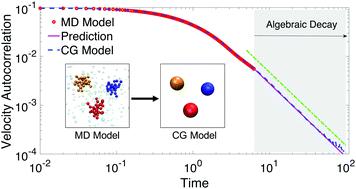当前位置:
X-MOL 学术
›
Soft Matter
›
论文详情
Our official English website, www.x-mol.net, welcomes your
feedback! (Note: you will need to create a separate account there.)
Data-driven coarse-grained modeling of polymers in solution with structural and dynamic properties conserved.
Soft Matter ( IF 2.9 ) Pub Date : 2020-07-23 , DOI: 10.1039/d0sm01019g Shu Wang 1 , Zhan Ma 1 , Wenxiao Pan 1
Soft Matter ( IF 2.9 ) Pub Date : 2020-07-23 , DOI: 10.1039/d0sm01019g Shu Wang 1 , Zhan Ma 1 , Wenxiao Pan 1
Affiliation

|
We present data-driven coarse-grained (CG) modeling for polymers in solution, which conserves the dynamic as well as structural properties of the underlying atomistic system. The CG modeling is built upon the framework of the generalized Langevin equation (GLE). The key is to determine each term in the GLE by directly linking it to atomistic data. In particular, we propose a two-stage Gaussian process-based Bayesian optimization method to infer the non-Markovian memory kernel from the data of the velocity autocorrelation function (VACF). Considering that the long-time behaviors of the VACF and memory kernel for polymer solutions can exhibit hydrodynamic scaling (algebraic decay with time), we further develop an active learning method to determine the emergence of hydrodynamic scaling, which can accelerate the inference process of the memory kernel. The proposed methods do not rely on how the mean force or CG potential in the GLE is constructed. Thus, we also compare two methods for constructing the CG potential: a deep learning method and the iterative Boltzmann inversion method. With the memory kernel and CG potential determined, the GLE is mapped onto an extended Markovian process to circumvent the expensive cost of directly solving the GLE. The accuracy and computational efficiency of the proposed CG modeling are assessed in a model star-polymer solution system at three representative concentrations. By comparing with the reference atomistic simulation results, we demonstrate that the proposed CG modeling can robustly and accurately reproduce the dynamic and structural properties of polymers in solution.
中文翻译:

在保留结构和动态特性的情况下,数据驱动的聚合物粗粒建模在溶液中进行。
我们提出了溶液中聚合物的数据驱动的粗粒度(CG)建模,该模型保留了基础原子系统的动态以及结构特性。CG建模基于广义Langevin方程(GLE)的框架。关键是通过直接将GLE中的每个术语链接到原子数据来确定它们。特别是,我们提出了一种基于两步高斯过程的贝叶斯优化方法,以从速度自相关函数(VACF)的数据中推断出非马尔可夫记忆核。考虑到VACF和记忆核在聚合物溶液中的长期行为会表现出流体动力定标(代数衰减随时间变化),我们进一步开发了一种主动学习方法来确定流体动力定标的出现,从而可以加快流体动力学定标的推论过程。内存内核。所提出的方法不依赖于如何构造GLE中的平均力或CG势。因此,我们还比较了构建CG潜力的两种方法:深度学习方法和迭代Boltzmann反演方法。确定了内存内核和CG潜力后,GLE被映射到扩展的马尔可夫过程中,从而避免了直接解决GLE的昂贵成本。建议的CG模型的准确性和计算效率在星形聚合物溶液模型系统中三个代表性浓度下进行了评估。通过与参考原子模拟结果进行比较,我们证明了所提出的CG模型可以鲁棒而准确地重现溶液中聚合物的动态和结构性质。
更新日期:2020-09-23
中文翻译:

在保留结构和动态特性的情况下,数据驱动的聚合物粗粒建模在溶液中进行。
我们提出了溶液中聚合物的数据驱动的粗粒度(CG)建模,该模型保留了基础原子系统的动态以及结构特性。CG建模基于广义Langevin方程(GLE)的框架。关键是通过直接将GLE中的每个术语链接到原子数据来确定它们。特别是,我们提出了一种基于两步高斯过程的贝叶斯优化方法,以从速度自相关函数(VACF)的数据中推断出非马尔可夫记忆核。考虑到VACF和记忆核在聚合物溶液中的长期行为会表现出流体动力定标(代数衰减随时间变化),我们进一步开发了一种主动学习方法来确定流体动力定标的出现,从而可以加快流体动力学定标的推论过程。内存内核。所提出的方法不依赖于如何构造GLE中的平均力或CG势。因此,我们还比较了构建CG潜力的两种方法:深度学习方法和迭代Boltzmann反演方法。确定了内存内核和CG潜力后,GLE被映射到扩展的马尔可夫过程中,从而避免了直接解决GLE的昂贵成本。建议的CG模型的准确性和计算效率在星形聚合物溶液模型系统中三个代表性浓度下进行了评估。通过与参考原子模拟结果进行比较,我们证明了所提出的CG模型可以鲁棒而准确地重现溶液中聚合物的动态和结构性质。









































 京公网安备 11010802027423号
京公网安备 11010802027423号